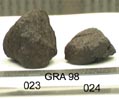
| MetSoc Home Publications Contacts |
 |
||
|
||
| Graves Nunataks 98050 | |||||||||||||||||||||
|---|---|---|---|---|---|---|---|---|---|---|---|---|---|---|---|---|---|---|---|---|---|
| Basic information | Name: Graves Nunataks 98050 This is an OFFICIAL meteorite name. Abbreviation: GRA 98050 Observed fall: No Year found: 1998 Country: Antarctica [Collected by US Antarctic Search for Meteorites program (ANSMET)] Mass:  337 g 337 g | ||||||||||||||||||||
| Classification history: |
This is 1 of 78 approved meteorites classified as H3.8. [show all] Search for other: H chondrites, H chondrites (type 3), Ordinary chondrites, and Ordinary chondrites (type 3) | ||||||||||||||||||||
Writeup |
Writeup from AMN 23(1):
 Macroscopic Description: Kathleen McBride Thin Section Description: Tim McCoy
A single description suffices for these meteorites. The sections exhibit numerous small, well-defined chondrules (up to 1.5 mm) in a black matrix of fine-grained silicates, metal and troilite. Weak shock effects are present. Polysynthetically twinned pyroxene is extremely abundant. The meteorites are highly weathered. Silicates are unequilibrated; olivines range from Fa3-33, with most grains Fa18, and pyroxenes from Fs4-16. The meteorites are H3 chondrites (estimated subtype 3.8). | ||||||||||||||||||||
| Data from: MB84 Table A1 Line 51: |
|
||||||||||||||||||||
| Catalogs: |
| ||||||||||||||||||||
| References: | Published in Antarctic Meteorite Newsletter 23(1) (2000), JSC, Houston Published in Meteoritical Bulletin, no. 84, MAPS 35, A199-A225 (2000)
| ||||||||||||||||||||
| Photos: |
| ||||||||||||||||||||
| Geography: |
Statistics: This is 1 of 44543 approved meteorites from Antarctica (plus 3802 unapproved names) | ||||||||||||||||||||
| Proximity search: | |||||||||||||||||||||
| Crosslinks: |
This lists all records that are linked to this record and to each other.
| ||||||||||||||||||||
| Also see: |
This lists the most popular meteorites among people who looked up this meteorite.
| ||||||||||||||||||||
| Revision history: |
This lists important revisions made to data for this record.
| ||||||||||||||||||||